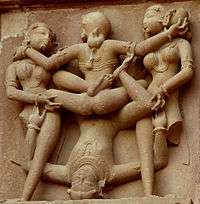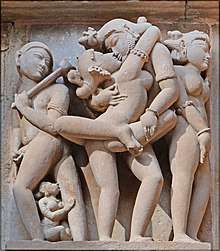Sexuality in India
India has developed its discourse on sexuality differently based on its distinct regions with their own unique cultures. However, one common aspect remains: the existence of a subtle conspiracy of silence and taboos that clouds the Indian world of sexual desires and expressions. The silence towards India's rich contributions to sexuality is a repercussion of colonial rule and of the Bible.[1] This shaped the attitude and opinions Indian people hold about their sexuality today; one that is hegemonically heterosexual and must aim at procreation after marriage. However, from the second half of the 20th century, several significant voices have challenged this silence imposed over sexuality and questioned the roles assigned to desires within the socio-political and artistic fields. Many recently published studies confirm the richness of India's erotic past and popular voices are now spotlighting this for the masses to know. A myriad of folk tales,[2] sculptures like those in Khajuraho,[3][4] religious poetry[5] and scholarly documents[6] reveal homoerotic content and how love and sex between women, men, gods, semi-gods and goddesses was expressed.
Background
The seeming contradictions of Indian attitudes towards sex (more broadly - sexuality) can be best explained through the context of history. India played a role in shaping understandings of sexuality, and it could be argued that one of the first pieces of literature that treated "Kama" as science came from the Indian subcontinent.[7] It may be argued that historically, India pioneered the use of sexual education through various art forms like sculptures,[8] paintings, and pieces of literature. As in all societies, there was a difference in sexual practices in India between common people and powerful rulers, with people in power often indulging in "self-gratification" lifestyles that were not representative of common moral attitudes. Moreover, there are distinct cultural differences seen through the course of history across India.
Ancient times
The origins of the current Indian culture can be traced back to the Indus Valley civilisation, which was contemporaneous with the ancient Egyptian and Sumerian civilisations, around 2700 BCE. During this period, the first evidence of attitudes towards sex comes from the ancient texts of Hinduism, Buddhism. These ancient texts, the Rig Veda among few others, reveal moral perspectives on sexuality, marriage and fertility prayers. The epics of ancient India, the Ramayana and Mahabharata, which may have been first composed as early as 500 BCE, had a huge effect on the culture of Asia, influencing later Chinese, Japanese, Tibetan culture and South East Asian culture. These texts support the view that in ancient India, sex was considered a mutual duty between a married couple, where husband and wife pleasured each other equally, but where sex was considered a private affair, at least by followers of the aforementioned Indian religions. It seems that polygamy was allowed during ancient times. In practice, this seems to have only been practiced by rulers, with common people maintaining a monogamous marriage. It is common in many cultures for a ruling class to practice both polyandry and polygyny as a way of preserving dynastic succession.
Nudity in art was considered acceptable in southern India, as shown by the paintings at Ajanta and the sculptures of the time. It is likely that as in most countries with tropical climates, Indians from some regions did not need to wear clothes, and other than for fashion, there was no practical need to cover the upper half of the body. This is supported by historical evidence, which shows that men in many parts of ancient India mostly dressed only the lower half of their bodies with clothes and upper part of body was covered by gold and precious stones, jewellery, while women used to wear traditional sarees made of silk and expensive clothes as a symbol of their wealth.
As Indian civilisation further developed and the writing of the Upanishads around 500 BCE, it was somewhere between the 1st and 6th centuries that the Kama Sutra, originally known as Vatsyayana Kamasutram ('Vatsyayana's Aphorisms on Love'), was written. This philosophical work on kama shastra, or 'science of love', was intended as both an exploration of human desire, including infidelity, and a technical guide to pleasing a sexual partner within a marriage. This is not the only example of such a work in ancient India, but is the most widely known in modern times. It is probably during this period that the text spread to ancient China, along with Buddhist scriptures, where Chinese versions were written.
It is also during 10th century to 12th century that some of India's most famous ancient works of art were produced, often freely depicting romantic themes and situations. Examples of this include the depiction of Apsaras, roughly equivalent to nymphs or sirens in European and Arabic mythology, on some ancient temples. The best and most famous example of this can be seen at the Khajuraho complex in central India built around 9th to 12th century.
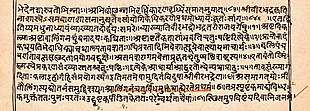 A Kamasutra manuscript page preserved in the vaults of the Raghunatha Hindu temple in Jammu and Kashmir.
A Kamasutra manuscript page preserved in the vaults of the Raghunatha Hindu temple in Jammu and Kashmir.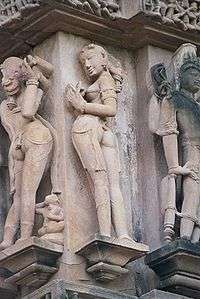 Depictions of Apsaras from the Khajuraho temple complex.
Depictions of Apsaras from the Khajuraho temple complex.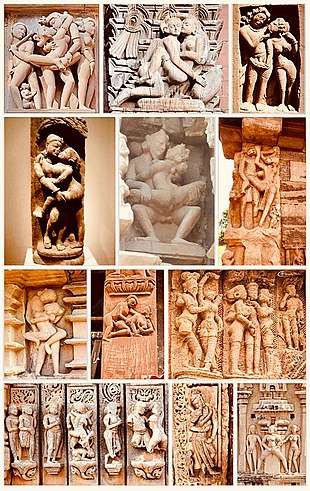 Kama-related arts are common in Hindu temples. These scenes include courtship, amorous couples in scenes of intimacy (mithuna), or a sexual position. Above: 6th- to 14th-century temples in Madhya Pradesh, Uttar Pradesh, Rajasthan, Gujarat, Karnataka, Chhattisgarh, Odisha, Tamil Nadu, Andhra Pradesh, and the Himalayas.
Kama-related arts are common in Hindu temples. These scenes include courtship, amorous couples in scenes of intimacy (mithuna), or a sexual position. Above: 6th- to 14th-century temples in Madhya Pradesh, Uttar Pradesh, Rajasthan, Gujarat, Karnataka, Chhattisgarh, Odisha, Tamil Nadu, Andhra Pradesh, and the Himalayas.
Colonial-era

Although the Portuguese and French had managed to set up some small enclaves in India, such as Goa, where the Catholic Inquisition forcibly converted some of the population of the small region to Catholicism, it was the arrival of the British, who managed to annex the entire Indian subcontinent through alliances with various monarchs, that had the largest effect on the culture of India and its attitudes to sex. The rule was indirect at first through the East India Company whose administrators did not necessarily interfere extensively and even took advantage of the tattered remnants of Hindu liberalism in sexual matters, for example through liaisons and by maintaining de facto wives. At the same time, there were significant number of orientalists who saw India as a great civilisation, invented the field of Indology, and advocated a more accepting point of view.
A number of movements were set up by prominent citizens, such as the Brahmo Samaj in Bengal and the Prarthana Samaj in Bombay Presidency, to work for the 'reform' of Indian private and public life. Paradoxically while this new consciousness led to the promotion of education for women and (eventually) a raise in the age of consent and reluctant acceptance of remarriage for widows, it also produced a puritanical attitude to sex even within marriage and the home. The liberality of pre-colonial India had also respected the home and relationships.
Current issues
Conservative views of sexuality are now the norm in the modern republic of India, and South Asia in general. It is often argued that this is partly related to the effect of colonial influence, as well as to the puritanical elements of Islam in countries like Pakistan (e.g. the Islamic revivalist movements, which has influenced many Muslims in Pakistan and Bangladesh). However, such views were also prevalent in the pre-colonial era, especially since the advent of Islam in India which brought purdah as ideal for Muslim women. Before the gradual spread of Islam largely through the influence of Sufis, there seems to be evidence of liberal attitudes towards sexuality and nudity in art. However, scholars debate the degree to which Islam, as a mass and the varied phenomenon was responsible for this shift.
While during the 1960s and 1970s in the west, many people discovered the ancient culture of sexual liberalism in India as a source for western free love movements, and neo-Tantric philosophy, India itself is currently the more prudish culture, embodying Victorian sensibilities that were abandoned decades ago in their country of origin. However, with increased exposure to world culture due to globalisation, and the proliferation of progressive ideas due to greater education and wealth, India is beginning to go through a western-style sexual revolution of its own, especially in cosmopolitan cities.
Modern India
Modern issues that affect India, as part of the sexual revolution, have become points of argument between conservative and liberal forces, such as political parties and religious pressure groups. These issues are also matters of ethical importance in a nation where freedom and equality are guaranteed in the constitution.
Sexuality in popular entertainment
The entertainment industry is an important part of modern India, and is expressive of Indian society in general. Historically, Indian television and film has lacked the frank depiction of sex; until recently, even kissing scenes were considered taboo. On the other hand, rape scenes or scenes showing sexual assault were shown. Currently, some Indian states show soft-core sexual scenes and nudity in films, whilst other areas do not. Mainstream films are still largely catered to the masses.
Pornography
The distribution and production of pornography are both illegal in India; however, accessing pornography in private is not. Regardless, softcore films have been common since the late 1970s, and many directors have produced them. Magazine publications like Debonair (magazine), Fantasy, Chastity, Royal Magazine, and Dafa 302 exist in India, and more than 50 million Indians are believed to see porn on a daily basis.
The Information Technology Act, Chapter XI Paragraph 67, the Government of India clearly considers the transmission of pornography through any electronic medium as a punishable offence. The CEO of the Indian subsidiary of eBay was charged with various criminal offences for allowing the trading of a CD on the website that contained pornography.[9]
Sex industry
While trade in sex was frowned upon in ancient India, it was tolerated and regulated so as to reduce the damage that it could do. Unfortunately, however, the stigmatisation that has arisen in modern times has left the many poor sex workers with problems of exploitation and rampant infection, including AIDS, and worse, it has allowed a huge people-trafficking industry, like that of Eastern Europe, to take hold. Many poor young women are kidnapped from villages and sold into sexual slavery.[10][11] There have been some recent efforts to regulate the Indian sex industry.
See also
- History of human sexuality
- Hinduism and sexual orientation
- Homosexuality in India
- Homosexuality and Hinduism
- Homosexuality and Sikhism
- Kamashastra
- Non-westernized concepts of male sexuality
References
- García-Arroya, Ana. First Indian Reprint: 2010, Alternative Sexualities in India.
- Pattanaik, Devdutt. 2002. The Man Who Was A Woman And Other Queer Tales.
- LINGIS, ALPHONSO. "KHAJURAHO." Soundings: An Interdisciplinary Journal, vol. 62, no. 1, 1979, pp. 52–69. https://www.jstor.org/stable/41178110.
- Allen, James Sloan. "The Mystery of the Smiling Elephant: In the Erotic Temples of Khajuraho." The Georgia Review, vol. 53, no. 2, 1999, pp. 321–340. https://www.jstor.org/stable/41401706.
- Kidwai, Saleem and Vanita, Ruth. 2000. In Same-Sex Love in India
- Thadani, Giti. 1996. Sakhiyani: Lesbian Desire in Ancient and Modern India
- Vātsyāyana, Richard F. Burton, and ibn M. 'Umar. The Kama Sutra. New York: Diadem Books, 1984. Print.
- Sahai, Surendra.1999. Khajuraho: The Art of Love, Prakash Book Depot
- "Avnish Bajaj back in Safe Harbors". India Law and Tech Blog.
- "Sex workers to combat trafficking, BBC News, 2001". news.bbc.co.uk. Retrieved 21 March 2015.
- "HIV fears over trafficked Nepal sex workers, BBC News, 2007". news.bbc.co.uk. Retrieved 21 March 2015.
Further reading
- Alain Daniélou. The Complete Kama Sutra: The First Unabridged Modern Translation of the Classic Indian Text. Inner Traditions,1993 ISBN 0-89281-525-6.
- Doniger, Wendy. "The Mare's Trap, Nature and Culture in The Kama Sutra." Speaking Tiger, 2015. ISBN 978-93-85288-06-7.
- The Continent of Circe by Nirad C. Chaudhuri – this has a chapter devoted to the topic.
- CIOTTI, MANUELA. "'The Bourgeois Woman and the Half-Naked One': Or the Indian Nation's Contradictions Personified." Modern Asian Studies, vol. 44, no. 4, 2010, pp. 785–815. www.jstor.org/stable/40664946.
- Rao, Vidya. "‘Thumri’ as Feminine Voice." Economic and Political Weekly, vol. 25, no. 17, 1990, pp. WS31–WS39. www.jstor.org/stable/4396223.
- Tripathi, Laxminarayan. "Me Hijra, Me Laxmi." Oxford University Press, 2015. ISBN 9780199458264. Translated from the Marathi original by R. Raj Rao and P. G. Joshi.
- Revathi, A. "The Truth About Me, A Hijra Life Story." Penguin Books, India, 2010. ISBN 9780143068365. Translated from Tamil by V. Geetha.
- Vanita, Ruth. "love's rite, Same-Sex marriage in India and The West.". Palgrave Macmillan, 2005. ISBN 9781403981608.
- Narrain, Arvind. "Queer." BOOKS for CHANGE, 2004. ISBN 81 -87380 - 91 -8
- Parkinson, R.B. . "A Little Gay History." The British Museum Press, 2013. ISBN 978-0-231-16663-8.
- Edited by Sangari, Kumkum and Vaid, Sudesh. "Recasting Women, Essays in Colonial History." Zubaan Publishers Pvt. Ltd., 2003. ISBN 978-93-84757-73-1.
- Edited by Dasgupta, Rohit and Gokulsing, K. Moti. "Masculinity and Its Challenges in India." Mcfarland & Company, Inc., Publishers. 2041. ISBN 978-0-7864-7224-6.
- Alhuwalia, Sajam. "Rethinking Boundaries: Global and the Local in the History of Birth Control: an Indian Case Study," orig. in Journal of Women's History, 14: 4(2003); reprinted in Sue Morgan, ed., The Feminist History Reader (2006)
- Alhuwalia, Sajam."Demographic Rhetoric and Sexual Surveillance: Indian Middle Class Advocates of Birth Control, 1847-1947," in J. Mills and Satadru Sen, eds. Confronting the Body: The politics of Physicality in Colonial and Post-Colonial India (2003)
- Alhuwalia, Sajam."Sex and Reproduction: Politics of Birth Control in Colonial India.1920-1947. Indian Journal of Gender Studies. 2012.
External links
- * BBC Article on AIDS Awareness in India
- Indian Sex Life Survey - Average Ages, Statistics on Foreplay, Intercourse & Frequency, Extramarital & Premarital Data, Homosexuality in Indian Society and other such related issues
- History of Sex: Ancient India
- IASSTD & AIDS - Indian Association for the Study of Sexually Transmitted Diseases & AIDS
- India In World Sex Survey - Frequency of sex in India & other data
- The Pink Panties Campaign: The Indian Women's Sexual Revolution. Intersections: Gender and Sexuality in Asia and the Pacific Issue 23, January 2010
